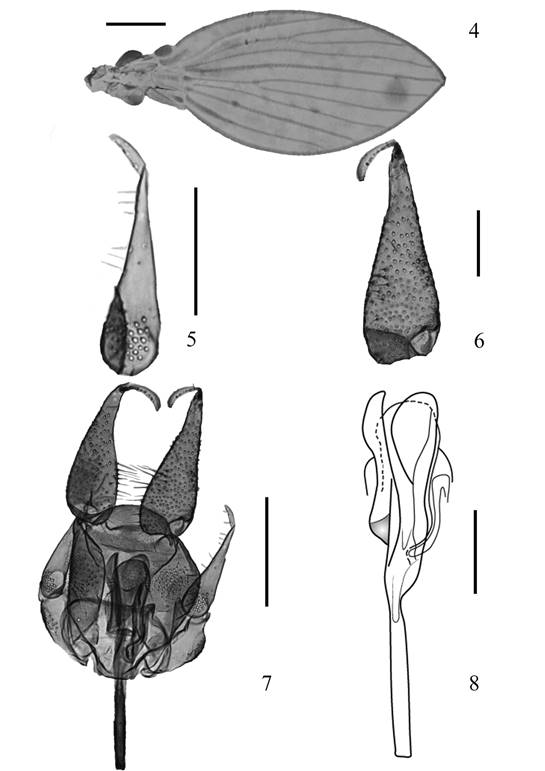Introduction
Psychodidae comprises 533 valid species in Brazil, where Psychoda Latreille, 1796 is one of the most diverse genera, with 27 registered species (Shimabukuro et al., 2018), distributed from North to South of the Country. The sexual association in Psychoda is difficult due to the high diversity on this genus, the high rate of sympatric species, and the resemblance of closely related species (Cordeiro et al., 2011). For these reasons, several species have been described based on only one sex. In Latin America and the Caribbean region, for example, more than half of the species are known by one sex only (Bravo et al., 2006; Cordeiro et al., 2011). Often the authors have chosen to base their descriptions on females, as they are frequently more abundant in traps and also exhibit conspicuous specific diagnostic characters in the terminalia (Quate, 1996; Cordeiro et al., 2011). The present study provides the description of the male of Psychoda serraorobonensis, as well as a map with the known distribution of this species.
Material and methods
Specimens studied herein were collected at Reserva Ducke, located at km 26 of the Manaus-Itacoatiara road. They were collected with a bovine faeces bait, made of a sample of 1.5cm3 of cow dung, exposed in the field for five days. The material was brought to the laboratory and kept in plastic cups covered with 'saran wrap' at room temperature until the emergence of adults. The adults were preserved in 70% ethanol and identified using a stereomicroscope. Females are preserved in 70% etanol and the male was mounted on a permanent slide with Canada Balsam, following the procedure of Bravo (1996).
The terminology follows the proposal of Cummig & Wood (2009) with the specific term gonocoxal apodeme proposed by Quate & Brown (2004). A geographic distribution map of the species was created using Websoftware Simple Mappr.
Results
Psychoda serraorobonensis Bravo, Cordeiro & Chagas (Figs. 1-8)

Figures 1-3 Psychoda serraorobonensis: ♂ 1. Head in anterior view; 2. Head in posterior view; 3. Flagellomeres 9-13 [Scale 0,1 mm (1,2) 0,05 mm (3)].

Figures 4-8 Psychoda serraorobonensis: ♂ 4. Wing; 5. Gonostyli; 6. Surstyli; 7. Terminalia in dorsal view; 8. Aedeagus [Scale 0,2 mm (5) 0,1 mm (7) 0,05 mm (5,6,8)].
Psychoda serraorobonensisBravo, Cordeiro & Chagas, 2006: 10. Type-locality: Brazil, Bahia, Serra do Orobó, holotype female (MZUEFS). Add. Ref.: Bravo, 2007:327 (Citation); Cordeiro, Bravo & Carvalho, 2011:15 (Record).
Examined material. 1 ♂, 3 ♀ BRASIL, Amazonas, [Manaus], Reserva Ducke, 2°56'8.84"S; 59°57'43.24"O, xii.2016, fezes bovina, col. D. Andrade (INPA).
Diagnosis. Eyes separated by 1.0 (male) or 1.5-2.0 (female) facet diameters; antenna with 14 flagellomeres, the 3 apical subequal are reduced in size, 11th and 12th fused, 14th separated and spherical; ascoids Y-shaped; wing with medial fork incomplete; female subgenital plate pilose on distal half and with lateral margins convex; male terminalia with gonostyle coniform with a group of alveoli at base and short setae sparsealy distributed, aedeagus asymmetrical, bifid with left branch little longer and wider in dorsal view, one short sinuous paramere articulat with aedeagus and a small projection of the hypandrium, gonocoxal apodeme strongly sclerotized, pilose ventrally and with rounded distal margin.
Description. Adult male. Head: Eye bridge with four facet rows (Fig. 1); Eyes separated by a distance of 1.0 facet diameter (Fig. 1); Scape subcylindrical, pedicel spherical, flagellomeres 1-11 nodiform, 11th and 12th fused, 12th-13th reduced (14th lost, antenna broken), ascoids Y-shaped, palpal formula: 1,0:1,1:1,1:- (apical segment lost, palpus broken), labellum with three apical digitiform setae (‘teeth’).
Wing: radial fork complete, M2 close but not linked to M1 (Fig. 4). Terminalia (Figs. 7 and 8): hypandrium stripe-like with a small triangular posterior projection on one side, gonocoxites with a group of alveoli on lateral margin, gonostyli little longer than gonocoxite, coniform, with acute apex, a group of alveoli at base and short sparsely distributed setae on apical 2/3; gonocoxal apodeme strongly sclerotized, pilose ventrally and with rounded distal margin; aedeagus bifid, left branch little longer and wider in dorsal view, one short sinuous paramere articulates with aedeagus and ends on the small projection of the hipandrium; epandrium as long as wide, pilose, surstyli coniform, 1.5X the length of gonostyle, with one tenaculum at apex. Epiproct and hypoproct broadly oval, pilose. Female. Described by Bravo, Cordeiro & Chagas (2006).
Distribution (Fig. 9). Brazil (States of Amazonas, Bahia, São Paulo and Paraná) (Bravo et al., 2006; Cordeiro et al., 2011).
Comments. We are confident of the sexual association as not only the morphology of adults match, but also all adults emerged from a single sample of faeces. The morphology of all larvae and larvae exuviae found on the faeces are also identical, indicating there was a single species on that sample. Description of immatures are in preparation on a paper comprising other immatures of coprophagous Psychodini. P. serraorobonensis appears to have a wide distribution in Brazil.











 nueva página del texto (beta)
nueva página del texto (beta)



